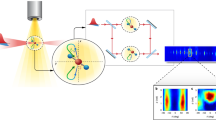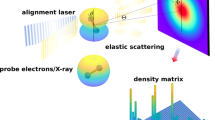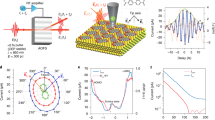Abstract
Single-electron wavefunctions, or orbitals, are the mathematical constructs used to describe the multi-electron wavefunction of molecules. Because the highest-lying orbitals are responsible for chemical properties, they are of particular interest. To observe these orbitals change as bonds are formed and broken is to observe the essence of chemistry. Yet single orbitals are difficult to observe experimentally, and until now, this has been impossible on the timescale of chemical reactions. Here we demonstrate that the full three-dimensional structure of a single orbital can be imaged by a seemingly unlikely technique, using high harmonics generated from intense femtosecond laser pulses focused on aligned molecules. Applying this approach to a series of molecular alignments, we accomplish a tomographic reconstruction of the highest occupied molecular orbital of N2. The method also allows us to follow the attosecond dynamics of an electron wave packet.
This is a preview of subscription content, access via your institution
Access options
Subscribe to this journal
Receive 51 print issues and online access
$199.00 per year
only $3.90 per issue
Buy this article
- Purchase on Springer Link
- Instant access to full article PDF
Prices may be subject to local taxes which are calculated during checkout





Similar content being viewed by others
References
Mulliken, R. S. Electronic structures of polyatomic molecules and valence. II. General considerations. Phys. Rev. 41, 49–71 (1932)
Linus, C. P. The Nature of the Chemical Bond and the Structure of Molecules and Crystals (Cornell Univ. Press, Ithaca, New York, 1960)
Brion, C. E., Cooper, G., Zheng, Y., Litvinyuk, I. V. & McCarthy, I. E. Imaging of orbital electron densities by electron momentum spectroscopy—a chemical interpretation of the binary (e, 2e) reaction. Chem. Phys. 270, 13–30 (2001)
Binning, G., Rohrer, H., Gerber, Ch. & Weibel, E. Surface studies by scanning tunneling microscopy. Phys. Rev. Lett. 49, 57–61 (1982)
Sakai, H. & Miyazaki, K. High-order harmonic generation in nitrogen molecules with subpicosecond visible dye-laser pulses. Appl. Phys. B 61, 493–498 (1995)
Liang, Y., Augst, A., Chin, S. L., Beaudoin, Y. & Chaker, M. High harmonic generation in atomic and diatomic molecular gases using intense picosecond laser pulses—a comparison. J. Phys. B 27, 5119–5130 (1994)
Velotta, R., Hay, N., Manson, M. B., Castillejo, M. & Marangos, J. P. High-order harmonic generation in aligned molecules. Phys. Rev. Lett. 87, 183901 (2001)
de Nalda, R. et al. Role of orbital symmetry in high-order harmonic generation from aligned molecules. Phys. Rev. A 69, 031804(R) (2004)
Hay, N. et al. Investigations of electron wave-packet dynamics and high-order harmonic generation in laser-aligned molecules. J. Mod. Opt. 50, 561–571 (2003)
Hay, N. et al. High-order harmonic generation in laser-aligned molecules. Phys. Rev. A 65, 053805 (2002)
Lein, M., Corso, P. P., Marangos, J. P. & Knight, P. L. Orientation dependence of high-order harmonic generation in molecules. Phys. Rev. A 67, 023819 (2003)
Parr, R. G. & Yang, W. Density-functional Theory of Atoms and Molecules (Oxford Univ. Press, New York, 1989)
Kak, A. C. & Slaney, M. Principles of Computerized Tomographic Imaging (Society for Industrial and Applied Mathematics, New York, 2001)
Stapelfeldt, H. & Seideman, T. Aligning molecules with strong laser pulses. Rev. Mod. Phys. 75, 543–557 (2003)
Stapelfeldt, H., Sakai, H., Constant, E. & Corkum, P. B. Deflection of neutral molecules using the nonresonant dipole force. Phys. Rev. Lett. 79, 2787–2790 (1997)
Sakai, H. et al. Controlling the alignment of neutral molecules by a strong laser field. J. Chem. Phys. 110, 10235–10238 (1999)
Larsen, J. J., Hald, K., Bjerre, N. & Stapelfeldt, H. Three dimensional alignment of molecules using elliptically polarized laser fields. Phys. Rev. Lett. 85, 2470–2473 (2000)
Sakai, H., Minemoto, S., Nanjo, H., Tanji, H. & Suzuki, T. Controlling the orientation of polar molecules with combined electrostatic and pulsed nonresonant laser fields. Phys. Rev. Lett. 90, 083001 (2003)
Rosca-Pruna, F. & Vrakking, M. J. J. Experimental observation of revival structures in picosecond laser-induced alignment of I2 . Phys. Rev. Lett. 87, 153902 (2001)
Dooley, P. W. et al. Direct imaging of rotational wave-packet dynamics of diatomic molecules. Phys. Rev. A 68, 023406 (2003)
Delone, N. B. & Krainov, V. P. Multiphoton Processes in Atoms (Springer, Heidelberg, 2000)
Corkum, P. B. Plasma perspective on strong-field multiphoton ionization. Phys. Rev. Lett. 71, 1994–1997 (1993)
Niikura, H. et al. Sub-laser-cycle electron pulses for probing molecular dynamics. Nature 417, 917–922 (2002)
Dietrich, P., Burnett, N. H., Ivanov, M. & Corkum, P. B. High-harmonic generation and correlated two-electron multiphoton ionization with elliptically polarized light. Phys. Rev. A 50, R3585–R3588 (1994)
Lewenstein, M., Balcou, Ph., Ivanov, M. Yu., L'Huillier, A. & Corkum, P. B. Theory of high-harmonic generation by low-frequency laser fields. Phys. Rev. A. 49, 2117–2132 (1994)
Burnett, K., Reed, V. C., Cooper, J. & Knight, P. L. Calculation of the background emitted during high-harmonic generation. Phys. Rev. A 45, 3347–3349 (1992)
Sanpera, A. et al. Can harmonic generation cause non-sequential ionization? J. Phys. B 31, L841–L848 (1998)
Mairesse, Y. et al. Attosecond synchronization of high-harmonic soft x-rays. Science 302, 1540–1543 (2003)
Yudin, G. & Ivanov, M. Yu. Nonadiabatic tunnel ionization: Looking inside a laser cycle. Phys. Rev. A 64, 013409 (2001)
Tong, X. M., Zhao, Z. X. & Lin, C. D. Theory of molecular tunneling ionization. Phys. Rev. A 66, 033402 (2002)
Spanner, M., Smirnova, O., Corkum, P. B. & Ivanov, M. Yu. Reading diffraction images in strong field ionization of diatomic molecules. J. Phys. B 37, L243–L250 (2004)
Otobe, T., Yabana, K. & Iwata, J.-I. First-principles calculations for the tunnel ionization rate of atoms and molecules. Phys. Rev. A 69, 053404 (2004)
Litvinyuk, I. V. et al. Alignment-dependent strong field ionization of molecules. Phys. Rev. Lett. 90, 233003 (2003)
Dunn, T. J., Walmsley, I. A. & Mukamel, S. Experimental determination of the quantum mechanical state of a molecular vibrational mode using fluorescence tomography. Phys. Rev. Lett. 74, 884–887 (1995)
Skovsen, E., Stapelfeldt, H., Juhl, S. & Mølmer, K. Quantum state tomography of dissociating molecules. Phys. Rev. Lett. 91, 090406 (2003)
Hankin, S. M., Villeneuve, D. M., Corkum, P. B., & Rayner, D. M. Nonlinear ionization of organic molecules in high intensity laser fields. Phys. Rev. Lett. 84, 5082–5085 (2000)
Lee, K. F. et al. Two-pulse alignment of molecules. J. Phys. B 37, L43–L48 (2004)
Acknowledgements
In addition to the NRC, we acknowledge financial support from the National Science and Engineering Research Council, Photonic Research Ontario, the Canadian Institute for Photonic Innovation, the Alexander von Humboldt-Stiftung and the Japan Society for the Promotion of Science. We thank M. Yu. Ivanov, M. Spanner, J. P. Marangos, M. Lein, P. H. Bucksbaum, I. A. Walmsley, D. Jonas, J. Tse and J. G. Underwood for discussions.
Author information
Authors and Affiliations
Corresponding author
Ethics declarations
Competing interests
The authors declare that they have no competing financial interests.
Rights and permissions
About this article
Cite this article
Itatani, J., Levesque, J., Zeidler, D. et al. Tomographic imaging of molecular orbitals. Nature 432, 867–871 (2004). https://doi.org/10.1038/nature03183
Received:
Accepted:
Issue Date:
DOI: https://doi.org/10.1038/nature03183
This article is cited by
-
Direct imaging of electron density with a scanning transmission electron microscope
Nature Communications (2023)
-
Lightwave electronics in condensed matter
Nature Reviews Materials (2023)
-
Coulomb and Quantum Interference Effects in the Spectra of High-Order Harmonics Generated by Aligned Molecules
Radiophysics and Quantum Electronics (2023)
-
High-order harmonic generation from aligned HCN molecules under orthogonally and linearly polarized two-color laser fields
Journal of Molecular Modeling (2023)
-
Attosecond streaking of sub-cycle electron wave packets for probing rescattering dynamics in an intense laser field
Journal of the Korean Physical Society (2023)
Comments
By submitting a comment you agree to abide by our Terms and Community Guidelines. If you find something abusive or that does not comply with our terms or guidelines please flag it as inappropriate.



